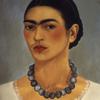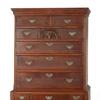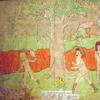From Ancient to Contemporary, The World’s Leading Asian Art Experts Recommend Exceptional Works for Under $5,000
- NEW YORK, New York
- /
- March 09, 2016
Although the Asian art market has been grabbing headlines in recent years for attaining one record price after another, many parts of that market are still undervalued, says Lark Mason, chairman of Asia Week New York, which runs from March 10 to 19. “Although there is a superabundance of exquisite objects on the market, the focus by the press is invariably on the high end, leaving many less expensive works under-publicized,” he says, adding, “For the beginning collector, now is one of the best times ever to acquire gorgeous artworks at very attractive prices.”
One of the finest values today is in the realm of Japanese art, Mason says, in particular, works from the Meiji period—be they in bronze, ceramic or other media—as well Japanese woodblock prints and Namban wood and lacquer objects. Mason notes that, even in a market frequently touted as booming, there are still Japanese screens to be had for a bargain.
Carol Conover of Kaikodo LLC, points to a Japanese painting titled Skull Amidst Grass by Kunii Obyun. “Priced at $3,500, this 19th-century Japanese work is of superb quality, as so many other Japanese paintings are from that era,” says Conover. “The subjects are more often than not highly intriguing, and the works all share a contemporary sensibility. They are very undervalued because at present they are not an area collected by the Japanese themselves.”
One of the most important and influential genres of art, which is accessible in the field of Asian art are Japanese prints, more specifically, ukiyo-e (art of the floating world),”says Katherine Martin, of Scholten Japanese Art, whose exhibition is devoted exclusively to the most classic type of ukiyo-e, focusing on the stories hinted at by clues in the compositions. “One of my absolute favorites is a stunningly well-preserved print by Keisai Eisen (1790-1848), titled Modern Specialties and Dyed Fabrics: Sound of Insects at the Bank of the Sumida, circa 1830. It’s an amazing example of a print of this type,which is becoming increasingly hard to find in today’s market. And yet, for all this beauty the print is priced at $3,800.
Also specializing in Japanese art, Joan B. Mirviss, Ltd. is offering a contemporary carved and glazed stoneware tea bowl by Takemura Yuri titled Mysterious Spirit. “Working in a historically male-dominated profession, female contemporary ceramists are usually overshadowed,” says Mirviss. “Takemura Yuri has beat the odds and has risen to renown at the notably young age of 36. Her distinctive interpretation of on a centuries-old ceramic form, the tea bowl, represents the quintessence of her style—the application of soft pastel colors to smooth, swirling designs adorned with polka dots and stripes. Her work is affordable now, priced at less than $5,000, but it won’t be for long.”
According to Erik Thomsen, Japanese gold lacquer works, such as the gourd tea caddy by Mizuuchi Kyōhei that he is offering, are underappreciated because few collectors realize gold lacquer works are produced only in Japan, and they are not widely known or collected. “One can therefore still acquire enchanting items like this caddy, with high-quality work and a striking design, for the reasonable price of $4,900,” he says.
Other good buys can be had in contemporary Japanese photography. “There is a great group of young Japanese photographers who have broken free of traditions, and their work is often under $2,000,” says Laurence Miller of the Laurence Miller Gallery. He is offering limited-edition prints by Yoko Ikeda for $1,000.
Mason says that the less-noticed cultures of South Asia also offer uncommon value for the money. Early works of art from Burma (Myanmar), Thailand, Cambodia, Sri Lanka and Vietnam include sublime representations of the international style of Buddhist art, often at a fraction of the cost of similar works from China.
Karsten Tietz of Berlin-based Buddhist Art Gallery adds that while “authentic pieces are considerably more expensive than reproductions, they are still bargains compared to other areas of Asian art.” During Asia Week, Tietz is offering a silver repoussé Buddha dating from 1920 and priced at less than $5,000.
Even within the red-hot Chinese art market, there are categories that offer favorable openings for an astute collector. According to Mason, early ceramics are one of the most undervalued areas in the market today, as are the many examples of regional and provincial works in wood and other organic materials. Chinese Export works of art and porcelain, a trade that dominated the international economy for hundreds of years, also offer hard-to-resist opportunities.
Martha Sutherland of M. Sutherland points to another underappreciated aspect of Chinese Art. “Album leaves are a savvy way to collect more affordable pieces by artists whose larger works are exponentially more costly. One of the artists that I represent, Hsia Ifu, paints highly detailed miniature landscapes on various sizes of album leaves. His brushwork is so intricate that each time you view a piece, you find something new. It’s priced at $5,000. I also have album leaves by the Nanjing artist Hai Tao that are painstakingly executed in the ‘mo gu’ brushwork style, which means ‘no bones,’ a method of building up multiple layers of wash with no discernible outline. It creates fantastic landscape forms, and the work is priced at $4,500.”
Regional works of all types from Asia contain many treasures overlooked by the market, says Mason. The interesting mix of East and West found in Gandharan sculpture is often underpriced, as are the works of art and furniture created in the teeming trade centers of India, Indonesia and other locations where Eastern ideas met Western trade, resulting in a new-fashioned blend of cultures.
“Indian Folk and Tribal works are still quite undervalued,” says Sanjay Kapoor of Kapoor Galleries. “The Nayak Period is still relatively early, yet not as widely collected as other, earlier, South Indian Dynasties—Chola, Vijaynagara, Hoysala and others—therefore the prices are very attractive. Casting techniques may not be as refined as the Cholas, but there is a lot of character in the bronzes—they still retain a bit of history. Our bronze is an exceptionally powerful and delicate cast and comes at a price less than $5,000.”
Navin Kumar, of his eponymous gallery, says that within Indian painting, works originating from Rajasthan are currently undervalued. He is offering a gouache on paper made in that region around 1800. It depicts a maharaja riding a horse and is priced at $3,500.
Lark Mason concludes by observing, “I often find overlooked gems in even the most prominent sales—areas that don’t quite fit the normal categories or that don’t dominate fields of collecting. Although they tend to get passed by, these treasures offer good deals. In addition to dealer’s galleries, auctions are a great place to find excellent values. As I’ve come to learn over the many years I’ve been doing this: The most surprising aspect of Asian art is the vast number of cultures represented. There is so much that can be yours without breaking the bank.”
About Asia Week New York
The 2016 edition of Asia Week New York offers an overflowing schedule of gallery open houses; auctions at Bonhams, Christie’s, Doyle, iGavel and Sotheby’s; exhibitions, lectures, symposia and special events.
To celebrate the Asia Week festivities, a private invitation-only reception, jointly hosted with the Department of Asian Art of The Metropolitan Museum of Art, will take place there on March 14.
A comprehensive guide with maps will be available at participating galleries, auction houses and cultural institutions, and online at asiaweekny.com.
Affirming the strength of interest from Chinese-speaking buyers, a Chinese version of the website is available at cn.asiaweekny.com.
Asia Week New York Association, Inc. is a 501(c) 6 non-profit trade membership organization registered with the state of New York.
About the Hotel Sponsor
The Asia Week New York Association has announced that The Surrey, New York City’s only Relais & Châteaux hotel, is the official hotel sponsor for the ten-day round of exhibitions, auction sales, and lectures. Asia Week New York attendees will receive exclusive rates from $395 per night (for a minimum of five nights) at The Surrey using promotion code ASIAWK or phone 888-419-0052.
The Surrey, located at 24 East 76th Street, is owned and operated by Denihan Hospitality Group. An intimate hideaway to the stars of the 1920s, it currently operates more like a glamorously re-imagined Beaux Arts townhouse than hotel. Its location provides cultured guests direct access to Central Park, The Metropolitan Museum of Art, and top fashion houses, restaurants, and art galleries on Madison Avenue, yet the hotel’s discreet service allows for calm personal space for a “Privately New York” experience. The Surrey offers an extensive art collection, world-class dining by Café Boulud, the atmospheric Bar Pleiades, Cornelia Spa and a Private Roof Garden. Its 189 exquisite salons and suites were created by Lauren Rottet, accommodating celebrities, style-icons and art aficionados the world over. For information and reservations, visit www.thesurrey.com.






100x100_c.jpg)



![Peter Paul Rubens (Flemish, 1577–1640), After Titian (Tiziano Vecelli) (Italian [Venetian], c. 1488–1576), Rape of Europa, 1628–29. Oil on canvas, 71 7/8 x 79 3/8 in. Peter Paul Rubens (Flemish, 1577–1640), After Titian (Tiziano Vecelli) (Italian [Venetian], c. 1488–1576), Rape of Europa, 1628–29. Oil on canvas, 71 7/8 x 79 3/8 in.](/images/c/e2/2e/Jan20_Rape_of_Europa100x100_c.jpg)





